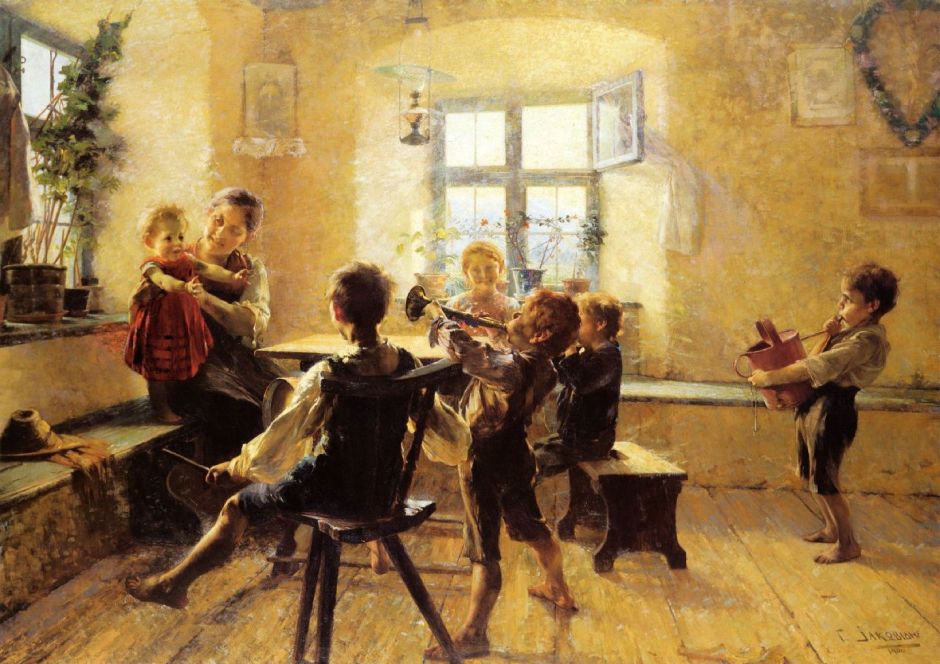In the first of this pair of articles showing paintings of concerts, I looked at works from the Renaissance to the middle of the nineteenth century. Today I progress through the latter half of that century into the twentieth, when it seems that everyone started taking pleasure in concerts and other musical performances.

Perhaps the best-known painting of an outdoor concert is also one in which there is no visible sign of musicians: Édouard Manet’s Music in the Tuileries from 1862. Packed into its rhythmic layout of trees are the members of the fashionable Parisian crowd, who have come to listen to the music, socialise, and chat. Historians have identified many of Manet’s circle among the crowd: the poet Baudelaire, novelist Gautier, composer Offenbach, Fantin-Latour the painter, and the artist’s brother Eugène, a painter who married Berthe Morisot, the Impressionist. Others in the crowd have been anonymised, and like many of his paintings it lacks the sparkling finish expected by the Salon.

On the other side of the Channel, Albert Joseph Moore assembled The Quartet, a Painter’s Tribute to Music in 1868. This is a decidedly strange painting: all seven figures are dressed for classical times, yet the instruments which they’re playing didn’t exist until the sixteenth century, and the double bass developed from the violone rather later than that. I’d also be most interested to learn of the music which might have been played by an Augustinian string quartet: the modern string quartet didn’t really exist before Haydn in the mid-1760s.

James Tissot’s Hush! from about 1875 shows a musical performance in a private residence, attended by the cream of society, no doubt. Among the honoured guests at the right are two from the Asian continent, but the distinguished host is still awaited, their chair empty, and the violinist poised to begin her command performance once they are ready.

A little later in the century, Edgar Degas painted a less formal work showing The Orchestra at the Opera (c 1870), in which the bassoonist closest to the viewer is visibly playing. For once we can guess what we should be hearing here, given the ballet taking place on the stage behind. Could it be one of the more famous bassoon passages from Tchaikovsky’s Swan Lake, perhaps?

Marie Spartali Stillman’s Fiammetta Singing (1879) is based on Boccaccio’s sonnet Of Fiammetta Singing, probably using Dante Gabriel Rossetti’s verse translation. Fiammetta, in red at the left, is singing to the accompaniment of a lute. Like Moore’s painting of the quartet above, this is also associated with the Aesthetic movement, which sought to bring together different creative modalities including visual arts and music.

The Impressionist movement coincided with the rise in popular musical performances, such as that shown in Manet’s Corner of a Café-Concert from 1878-80. These musicians, instruments and their audience are very different from those of Degas’ Opera.

Musical concerts remained a favourite home entertainment, as shown in Fritz von Uhde’s Family Concert from 1881.

Paintings were also made as records of concerts in different cultures. Kamal-ol-molk’s فارسی: عمله طرب، نوازندگان و رقصندگان عصر ناصری shows a Music Group in Naser al-din Shah Ara in Iran, in 1886. Although I recognise among their instruments a dulcimer – in fact a santur – at the right, I have no idea what this group might have sounded like. It’s worrying, though, that the large red-haired man at the back, on the left, appears to be brandishing a knife.

A few artists continued to paint historical scenes showing music among the nobility of the past. This is François Flameng’s undated painting of a Concert at Versailles.
The late nineteenth century also saw the rise of the musical celebrity, particularly singers who would tour the cities of Europe or the US captivating their audiences.

Thomas Eakins’ portrait of the singer Weda Cook (1867-1937) as The Concert Singer (1890-92) was his first full-length portrait of a woman. She was known for her powerful contralto voice, and Eakins reduced distractions so that the painting is almost exclusively about Cook. There is just the glimpse of a potted palm, the disembodied conductor’s hand and baton, and a bouquet of roses thrown at her feet.
Eakins and Cook fell out late during the painting of this work, apparently over Eakins’ repeated insistence that he wanted her to pose disrobed. In the end he had to complete it using just her dress and shoes, but the two were reconciled three years later.

Children’s concerts are usually more spontaneous, less disciplined, and far more fun, as shown in Georgios Jakobides’ Παιδική Συναυλία (Children’s Concert) from 1894.

Pompeo Massani’s The Orchestra Rehearsal from around 1900 captures this well, but I don’t find this as vivid an evocation as Jakobides’ children.

Among the more highbrow paintings of concerts is Julius Schmid’s Schubertiade. This was painted in 1897 to celebrate the Austrian composer’s centenary, and shows him performing to a packed audience in the early years of the century.

Between 1908-26, Édouard Vuillard lived in a fifth floor apartment in Rue de Calais, Paris, which overlooked what was then known as Place Vintimille, now Place Adolf-Max. In his Morning Concert, Place Vintimille from 1937-38, a trio of friends are playing for the artist in that apartment.
I hope these marvellous paintings have reminded you of some of the sensory riches of the concert. I can’t wait for them to return.

